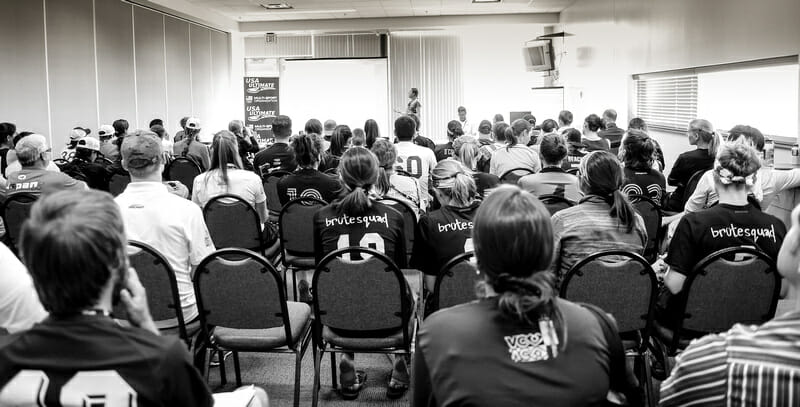Leaders in the ultimate community share a series of concerns about the proposed shift of the club season timing.
February 17, 2016 by Ultiworld in Opinion with 34 comments

The release of USAU’s survey about shifting the club series to the summer months has sparked a strong reaction from the ultimate community. We asked a small, diverse group of community members to speak about ways in which the proposed club schedule would impact them and those closest to them. While many of these writers hold a variety of roles in the community, we asked them to focus on only one or two of the largest impacts that they expected if the proposed schedule was adopted.
*
![]() Tiina Booth
Tiina Booth
Head Coach of UMass Men
Director of the National Ultimate Training Camp
I feel like I am watching a display of Falling Dominoes, the one where thousands of dominoes are arranged on a large floor. In the beginning, pretty patterns emerge and delight the audience. By the end, every domino is lying on its side and someone has to pick them all up and and build something new. Or is it rebuild?
Here is how the shorter season will hurt youth players. We have had a coaching crisis in the US for years. We simply do not have enough coaches to keep up with the demand. Club players, of all flights, often fill those roles. Shortening the season will leave these youth teams stranded or disbanded as their coaches are forced, by our governing body, to make a choice. Young women’s teams, including college, are particularly vulnerable as they tend to be the newest teams and need the most support.
In addition, I work hard at selecting excellent counselors with a variety of backgrounds to teach at my camp. Almost without exception, these athletes want to work at camp but have conflicts with their club teams, whether it is a tournament or practice. The campers want to learn from them, the counselors want to teach, and yet now their availability will be even more restricted. I expect other camps and youth leagues and certainly YCC teams run into this exact problem. Much of the magic that hooks young players happens in the summer; they play an evening game, hang around afterwards with friends, and throw in the dark until they can’t see the disc anymore.
Finally, this move continues to discourage the building and growth of club teams, of every flight and every division. We are all interconnected and I do not mean on a cosmic level. The high school coach tries out for a team and invites some of their players to join them. The elite player becomes a counselor and talks up their college program to young campers. The college player goes home for the summer and volunteers to coach a YCC team. Club teams develop and strengthen out of these experiences. That is how our sport currently works, dammit. At least that’s how it works on the front lines.
Stop kicking over the dominoes, USAU.
*
![]() Kyle Weisbrod
Kyle Weisbrod
Head Coach of U. of Washington Element
Director of VC Ultimate Leadership Training Camp
Moving the Club Series earlier will have a direct and substantial negative impact on the participants in the college division. Already, with the current series timeline, the college team I’ve coached faces elite club team tryouts that run concurrently with the final weeks of our college season. Every year, this puts immense time pressure on players that tryout for and play club and significantly increases the rate of injury for those players in April and May. It creates conflict between the college and club teams as we compete for these players’ times and teach different systems.
An earlier club series will extend that conflict to exponentially more teams and players. Sectional and Regional level college teams will now face that conflict in the heart of the season while second tier club teams, who have been able to wait until after the college season to finalize rosters, will be forced to move their tryouts to the middle of the college series.
At the tail end, club teams that rely heavily on college players to even form a roster will not be able to organize a roster in time to compete in the regular season and many will likely fold, eliminating this crucial opportunity for development for young players. Last year, several players from University of Washington — along with other college players — formed a team, Grind, to compete in the series. The current schedule allowed the team to compete in regular season events to gain months of practice time prior to Conferences. A shifted club series would eliminate most of the season for a team like Grind and would very likely result in it not even forming.
As a college coach, I oppose moving the club series earlier as it will increase conflict between the college and club community, increase rates of injury and burnout for players trying to do both, and reduce important development opportunities for college players and others by squeezing out the bottom tier of club teams.
*
 Michelle Ng
Michelle Ng
Director of Without Limits
Elite Women’s Club Captain
The impact of moving the club season earlier on those of us that participate in the club series while also providing critical organizational support to the college season cannot be overstated. I organize a number of college ultimate tournaments and clinics around the country, with five events in a row starting in late February. In some years, I have hosted as many as ten college events. These tournaments and clinics are attended by teams ranging from perennial Nationals attendees to first year college teams hungry to learn and compete; I very much hope that these events have contributed to the growth of the college women’s division over the past eight years.
In addition to this, I have been a captain of Phoenix, one of two women’s club teams in the Raleigh-Durham area. Phoenix and Rogue (the other women’s team) have a mutually dependent relationship with our local college teams — we draw heavily on them for players and our players are very invested as youth and college coaches. In addition, we host a dozen pre-season skills sessions and community events for female ultimate players in our area which pack March and April, putting an enormous time and resource burden on organizers and leaders over the course of those months — and even longer when college teams qualify for Nationals. Scheduling is already difficult — players are forced to make tough choices between tryouts, practices, workouts, and the Series for the teams that they are on and the teams that they are trying to make.
Moving the club season a month earlier spells disaster. I already make concessions on my commitment to my club team because of the work I do in college ultimate and there are so many others everywhere who do the same. Forcing us to make choices between playing and organizing / leading will inevitably result in fewer opportunities for youth and college ultimate — divisions that USA Ultimate has specifically focused on for growth and development.
*
 Andrew Francis
Andrew Francis
SE Men’s College Region Director
Editor of Bama Secs
First, I would like to echo Michelle’s sentiment. I’m a college Regional Director, and while I enjoy doing the job, I would easily drop it if the shift happens. Right now, my duties end once Regionals are over at the beginning of May, giving me an entire month to go to any Club tryouts I want to attend. If my Club preseason were now shifted back into March/April, I would be forced to pick tryouts over College Series events. I’m not going to let volunteer duties get in the way of my playing season.
How does this calendar shift affect the non-competitive side of the summer? When Nationals was still on Halloween weekend, everyone considered Poultry Days the unofficial start of the season. Tryouts, practices, and X/Y tournaments happened in May and early June, and everyone gathered in Versailles for one last party weekend before we all focused on Sarasota in October. If we are supposed to be competing in TCT events in June and securing bids, how can we take the time to play these fun community events?
USAU loves to talk about the “ultimate community,” but moving the season around is already impacting events like Surf & Turf, Poultry Days, Potlatch, Shawn Adams, and Wildwood. The average non-Regional-level player is going to pick a weekend at Wildwood over playing Sectionals in late July weather every single time. Shawn Adams has already seen its ~50 team event on Labor Day weekend almost disappear in a single season with the shift to having sectionals in August.
I’m sure most of you have been on a summer league team with serious Club players before. What usually happens during the season? They have great attendance in May and June as they work on fitness and polishing their throws, but as July and August come, they end up skipping games more often for club practices and workouts. Shifting their more important games up earlier in the summer means they will just skip summer league completely.
League play is an important component to our sport as it exposes new players to not only the community, but also elite skills. I know the first time I showed up for a league game as a 17 year old kid in Huntsville, AL, I was mesmerized by what the club players could make a disc do. We are risking losing that cross-pollination of skill levels with this proposed calendar.
*
 Jimmy Mickle
Jimmy Mickle
Member of US Men’s National Team
Johnny Bravo
Dallas Roughnecks
Moving the club series a month earlier in the year will limit the development of college players as they will have fewer opportunities in the Club Series. I first started playing Club at 18 years old, after completing my freshman year of college. Most of my development as a club player happened in the early part of the season, June and July. As the season progressed, games became more important and I saw my playing time decrease. With the proposed season shift, college players wouldn’t be joining club teams until halfway through the season, missing a crucial development period. Much of my success is owed to my opportunity to play the highest level ultimate early in my career; moving the start of Club to earlier in the spring will prevent others from having the same chance.
There are some scenarios where the sacrifice might be worth it, but USAU needs to be more clear about the tangible advantages of the shift.
“It also opens up potential broadcast opportunities for the Post Season by moving it out of September, which is already packed with broadcast sports (e.g. football, baseball, basketball). Both options would be in line with strategic goals to gain positive visibility for the sport, to help drive growth.”
Two of the biggest ultimate events in the world, USAU College Nationals (Memorial Day Weekend) and the U.S. Open (4th of July Weekend), take place during times that aren’t packed with broadcast sports. If that’s the limiting factor, why aren’t these events on network TV? Why is Club Nationals different?
*
 Gwen Ambler
Gwen Ambler
Co-coach of Seattle Riot
Former USA Ultimate Board Vice President
Gender equity is repeatedly cited as an important value of our sport, yet the shift of the club season that USA Ultimate has proposed would especially undermine the growth and development of female ultimate players.
As with sports participation in general, the number of female athletes in ultimate lags behind the number of male athletes — at every level of the game. With a smaller pool of players and teams, changes to the club season often disproportionately affect the Women’s division. When the Club division moved from a six region format to an eight region format between the 2011 and 2012 seasons, the number of women’s teams at Sectionals dropped from 116 down to 65, a 44% decline. Meanwhile, the Men’s division saw a smaller dip in teams at Sectionals (36%), still had 100 more teams participating than the women’s division, and has had a subsequent higher growth rate during the era of the Triple Crown Tour.
Moving the end of the club season to late August will mean that club teams either have to (a) shift the start of their season earlier by 6-8 weeks or (b) shorten their season. Teams which choose to hold their tryouts earlier may miss out on recruiting all but the biggest name stars in the College division. This is the most likely scenario for many club teams in the Pro and Elite Flights that want to ensure their roster has enough time to develop the strategies it will need to make a run at the Championships. Access to the Club division has helped develop leaders on countless college teams, and is a critical component of the growth and increasing talent on display during the women’s College Series. Competing schedules essentially deny an opportunity for the development of many talented young women.
As compared to the Pro and Elite Flight, club teams in the Select and Classic Flights rely more heavily on college players to form their roster. These women’s teams don’t have the luxury of picking their roster in April without evaluating college players. Instead, they must wait until players are finished with their college seasons before practicing and competing in earnest. Truncating the club season for these teams puts them at a disadvantage as compared to teams in the other flights. A shorter season reduces the number playing opportunities teams can use to improve, and would exacerbate the gap that the Triple Crown Tour has been widening already. I predict a shift in the club season calendar will result in even less parity in the women’s division, an outcome no one wants.
Introducing another barrier to growth in the women’s division with the proposed calendar shift is going to hamper the possibilities that the division reaches its full potential in years to come.
*
 Robyn Wiseman
Robyn Wiseman
Member of US Mixed National Team
Madison Heist
Coach University of Wisconsin, GUM
USA Ultimate requires teams to submit event rosters for tournaments and sets expectations for season-long and post-season rosters, which are not unreasonable requirements. However, if the tournament event rosters are due at the beginning of April, that means we have to have tryouts in March, right?
Guess what the average high temperature is in mid-March in Wisconsin? My quick investigation tells me that I can expect it to fall between 32 and 41 degrees Fahrenheit, with at least 1/3 of calendar days experiencing freezing precipitation. I invite anyone to come and compete in these conditions and tell me you can assess skill in 25+ miles per hour wind and freezing rain at tryouts. I am not being overly dramatic: I am merely describing an average expected mid-March weekend in the state which I have lived for nearly my entire life. There is a reason that we do not have tryouts until May here, even though many of our competing clubs across the country have tryouts in April with the schedule in which we currently compete. Shifting the season earlier in the calendar year makes the challenges of a team like Heist more significant to overcome.
We literally cannot have outdoor tryouts before April 1st in the most ideal of years. If we step foot on one of our abundant parks before April 1, a Park Ranger hits not only individuals but our community ultimate organization, the Madison Ultimate Frisbee Association (MUFA), with fines and reprimands, jeopardizing the standing of ultimate in the entire community. April 1st assumes we do not have standing water, snow, or ice on the ground. If we use a facility that has not opened, we potentially affect our entire ultimate community’s ability to have a summer league.
Heist is not alone. All teams across divisions in the North Central, Great Lakes, Northeast, and parts of the Mid-Atlantic must shoulder this disproportionate adversity. Many of our smaller cities do not have turf infrastructure or even indoor facilities that allow ultimate to use them. We have smaller populations from which to draw athletes. We are forced to drive 12+ hours to tournaments because players cannot afford multiple $600+ plane tickets from regional airports. The number of meaningful events in which we are actually invited to compete continues to decrease.
Sure, some of this adversity bring our communities together and create a common bond, but if you also force us to adapt to practicing indoors or in unreasonable and dangerous outdoor conditions, it might be the straw that breaks our ability to sustain meaningful growth.